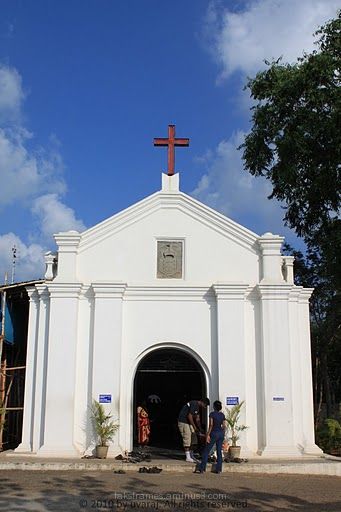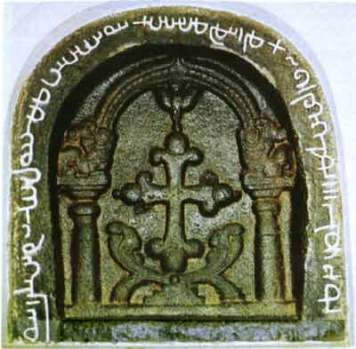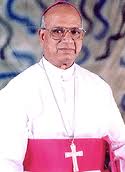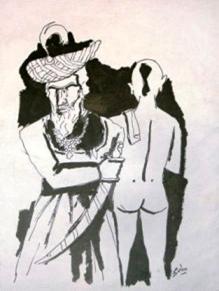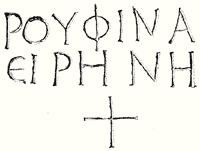“Journalists have a vested interest in ignorance.” – George Bernard Shaw
For the note on the early Christian FISH SYMBOL and their later use of the CROSS as an identifying mark, scroll to the bottom of this page.
The Deccan Chronicle is South India’s largest circulation pro-Christian newspaper and the newest proponent in Chennai of the St. Thomas in India fable (following The Hindu and The New Indian Express). It is a popular newspaper that depends entirely on Hindu subscriptions for its existence, and therefore must hide its anti-Brahmin, pro-Catholic agenda. This is done by promoting anti-Hindu views covertly from behind a columnist’s byline or by publishing the provocative statements of the local San Thome Cathedral priest. The priest, who cannot distinguish between his beliefs and real Indian history, declares: ”The existence of the San Thome Church is a proof by itself that Christianity in India is more than 2000 years old” (Deccan Chronicle, Chennai, 8 April 2007).
The San Thome Cathedral pastor is alluding to the St. Thomas in India legend and the claim that the apostle St. Thomas established Christianity in South India in 54 AD. The story is accepted tradition among Christians in Kerala. It is also a classic Christian persecution and martyrdom myth that was invented to malign and demoralise Christianity’s religious opponents. Christians have vilified Jews for 2000 years by blaming them for the murder of their god, and Christians have vilified Hindus for centuries by claiming that a Brahmin priest or Hindu king in Mylapore murdered St. Thomas. Both ancient communities, Jews and Brahmins — the latter being the custodians of Hindu culture — can thereafter be charged with deicide and subjected to the most wicked abuse and overt attempts to exterminate their religion and culture.[1] The mainstream media in India subscribes to this vicious communal agenda and promotes the fable in its columns at regular intervals though it has been aware of the legend’s falsehood and malefic intent for at least twenty years. This is inexcusable by any universal standard but gives a revealing insight into the nature of secular democracy and freedom of speech in India today. Hindus have no voice in the English-language print media and have become second class citizens in their own motherland. In states like Tamil Nadu they are virtually a disenfranchised people and under constant attack by an atheistic, racist government that overtly supports the foreign-financed Christian missions and NGOs that work in the state to alienate the Tamil people from their ancient civilization.
The Deccan Chronicle’s current resident editor in Chennai is cricket commentator R. Mohan, a self-righteous secularist of the Nehruvian school who assiduously follows the Christian practice of treating Hindu history as mythology and Christian mythology as history. In true Indian secularist fashion he does not tolerate dissent and letters sent to the editor concerning the lies and distortions that appear in Deccan Chronicle articles are neither acknowledged or published. Every effort is made by Mohan and his correspondents to provoke and insult Hindu readers and undermine their Hindu identity. This culturally subversive activity is called “freedom of the press” in our secular socialist India that is Bharat.
Chairman Reddy and resident house boy Mohan regard criticism of themselves and their “eminent” contributors — many of them foreigners based in London and New York — as a manifestation of Hindu communalism and ignorance. Indeed, dissent can attract a very spiteful response from Mohan Sahib (as this writer knows from experience). Yet both of these clever media men, whose decisions influence the opinions of half a million readers and more every day, will ignore facts and figures as extraneous irritants except where the facts and figures can be employed in subtle Hindu-bashing exercises[2] or otherwise to whitewash the bigoted, violent and licentious history of Islam and Christianity in India.
What follows is a collection of short items that are related to the St. Thomas legend, that appeared in the Deccan Chronicle in 2008. The items. called “name-stake” items with photos were published to establish the Christian ownership of the places they describe. The truth that all the places described once had Hindu temples on them until the Portuguese arrived, is thus negated and erased in the public mind.

LITTLE MOUNT
It is also called Chinna Malai, and is a little before St. Thomas Mount. There are two churches here, which are associated with the legends of the Apostle of India — Our Lady of Health Church and Blessed Sacrament Chapel. The annual festival at Our Lady of Health is a noteworthy event in the Madras calendar.— Deccan Chronicle, Chennai, 16 July 2008
Ishwar Sharan responds: The appellation “Apostle of India” for St. Thomas is a recent Roman Catholic invention conceived in 1953 when Cardinal Eugene Tisserant brought a piece of St. Thomas arm bone from Ortona to Kodungallur for a shrine. Prior to this date St. Francis Xavier held the title Apostle of India. Prof. Leonardo Olschki, a world authority on Christianity, writes,“The Nestorians of India [Syrian Christians] … venerated St. Thomas as the patron of Asiatic Christianity — mark, not of Indian Christianity”.
There are four places in Madras and its environs, other than San Thome, that the Portuguese associated with St. Thomas. The first is a rocky hillock called Little Mount, four miles southwest of Mylapore, on the south bank of the Adyar at Saidapet. Fr. Herman D’Souza, in In the Steps of St. Thomas, writes, “Hoary tradition among Catholics and non-Catholics … proudly holds that this part of [Madras] extended shelter to the Apostle, when the ministers of the local king, Mahadevan, were out to murder him…. The favorite of the king, Thomas was ever in danger of losing his precious life — thanks to the scheming ministers whipped up by Hindu priests…. There is a version that the Apostle was actually handled brutally more than once in his apartment, in the absence of the king. In order to save his life for yet a little while for the greater glory of God, Thomas is reported to have sought refuge in the jungle of Little Mount.”
This sly communal tale, invented by Jesuits and improved on by Fr. D’Souza, is peculiar to Madras [and still published by the San Thome Diocesan Press in Chennai]. He tries to establish Hindu support for the story, by quoting Hindu publications that repeat it. But Hindu traditions about Little Mount and other “St. Thomas” sites are quite different and much older than those of the Portuguese. They believe that the hillock, with its cave and spring and imprint of pea****’s feet in the rock, was sacred to Murugan, and Hindu women used to visit the site even after the Portuguese had cleared it of Hindu shrines. In 1551, a church was built by the cave, called Our Lady of Health, and the Jesuits built a second church by the spring. Nothing remains of these buildings today, and the archaeological evidence on the site was destroyed years ago when it was blasted to make way for the modern church that now stands there.
St. Thomas had to leave Little Mount when the king’s men found him in the cave. He fled to Big Mount [St. Thomas Mount], two miles further south, by a secret underground passage. But Big Mount did not offer refuge either. Fr. D’Souza writes, “His murderers sought him there and were on the point of seizing him. How long St. Thomas made his abode on top of the hill, one cannot say. Unbroken tradition maintains that while the Apostle was praying before a cross carved by him on a stone, an assassin suborned by King Mahadevan’s priest and ministers, crept up stealthily and pierced him with a lance from behind. Thereupon the Apostle is reported to have fallen on the stone cross and embraced it; his blood crimsoned the stone cross and the space around. Thus did he seal his Apostolate with his blood, even as the other Apostles, save St. John…. His disciples took his body to [Mylapore] … and interred it at his dear old place, about the year AD 68.”
This rendition of the fable has no equivalent in Malabar and no relationship to the account in the Acts of Thomas, though it does have in it the priest and the lance found in the Portuguese De Miraculous Thomae. There is no record that Mylapore had a temporal king of any name in 68 CE — the date first appeared on a memorial plaque in San Thome Cathedral in the eighteenth century and was afterwards incorporated into the story. But as is the case with many historical fabrications, it contains an element of truth and this gives the fictional parts credibility. Mahadevan is a reference to Lord Shiva, who was of course the King of Mylapore in the first century CE, even as He is the King of Mylapore today.

TOWN OF THOMAS
At the south end of Marina is San Thome, today a part of Mylapore. With its inspiring Basilica on a site where for 19 continuous centuries has stood some church or other. Just before the Basilica on this road is the former palace of the Maharaja of Mysore, now hidden behind formidable gates. Here live the representatives of Russia. — Deccan Chronicle,Chennai, 1 September 2008
Ishwar Sharan responds: The article above is a continuation of the Deccan Chronicle’s policy of prostituting Indian history to further its pro-Catholic agenda. Telling lies for Jesus — or in this case for his brother Thomas — has never been a problem of ethics for newspaper chairmen or editors who are born with Hindu names but who willingly sell their Hindu mothers down the river for a few dinars. The Deccan Chronicle and Asian Age are said to be owned by a Saudi Arabian company. There is no contradiction here between an Arab-owned Indian newspaper and its pro-Catholic agenda, as both Muslims and Christians and their secular Indian front men are willing to work together for the total annihilation of Hindu religion and culture.
Historically, the first Christian church to appear on the Mylapore beach was built in 1523 by Augustinian friars beside the new tomb of “St. Thomas” that had been dug and seeded with bones and other material brought from Goa by Albuquerque’s attendant Diogo Fernandez.
Earlier, in 1521–22, the Portuguese had opened two tombs in the Shiva temple’s northern precincts. One tomb contained a “black” skeleton, which, according to its inscription, belonged to a Chola king. The Portuguese nevertheless “identified” him as being a disciple of St. Thomas (as today Catholic historians “identify” Tiruvalluvar as being a disciple of St. Thomas). The second tomb revealed a “white” skeleton, which, naturally, “belonged” to the white Jew Thomas. This second skeleton was sent to Goa for verification – where it languishes till today, unsung and unrecognised.
As these diggings did not produce the required result, Diogo Fernandez was asked, in 1523, to excavate a third tomb which lay partly under the foundation of a dilapidated temple building that had been occupied by the Portuguese. He refused at first but was persuaded by the attending priest, Fr. Antonio Gil, who heard his confession and that of the two men, Braz Fernandez and Diogo Lourenco, who would assist him in the pious enterprise. They then began the excavation of a deep and elaborate, and very much empty, tomb. It was Saturday afternoon, and they continued the work into the late evening, when, on the suggestion of Diogo Fernandez, they abandoned their unproductive labours and retired for the night. The excavation was left open and unattended until the next morning, a Sunday, when the men began digging again. It was not long now before the grave disgorged bones that were “much worn out”, portions of skull and spine, and a clay pot of earth “bedewed with blood”, with a thigh bone in it, and hidden in the red earth an iron Malabar spearhead shaped like an olive leaf, which, after fifteen Christian centuries, still had a piece of wooden shaft miraculously preserved in its socket.
This church, originally built in 1523 and called San Thome or San Thome de Meliapore, was subsequently enlarged and extended, and the encroachment on the Kapaleeswara Temple began in earnest. The Christians had done this before, building a church against a temple and then slowing taking over the temple, and that the Shiva temple survived as long as it did, up to 1566 according to some authorities, is grand testimony to the patient and courageous resistance the Hindus of Mylapore had put up against this ruthless Catholic power.
In 1606 the Pope, at the request of the King of Portugal, made San Thome de Meliapore into a diocese independent of Goa. The church was extended again and became the seat of a bishop, but, in 1893, this building was demolished by the bishop and the present Gothic cathedral put up in its place. It was completed and consecrated in 1896. In 1952 the archdiocese of Madras and Mylapore was constituted, and in 1956, after much lobbying by the Indian hierarchy, Pope Pius XII raised the status of San Thome to that of a minor basilica. This church dignity is of no consequence but it affords the archbishop some minor liturgical privileges.
Diogo Fernandez’s “St. Thomas” relics still remain in the church today. The iron spearhead and piece of skull are kept in a monstrance, along with the relics of St. Francis Xavier, St. Isabella, St. Vincentio and the Martyrs of Morocco. The first “St. Thomas” tomb, which contained the “white” skeleton that was sent to Goa, is empty and ignored, but the second “St. Thomas” tomb has recently been renovated and refurbished at great expense and a new life-size plaster idol of a “sleeping” Thomas still clutching the spear that killed him lies on top of it and is pointed out to pilgrims and tourists. It contains the remainder of Diogo Fernandezs “findings”, the pieces of spine and thigh bone, and, presumably, the pot of “blood-bedewed” earth.
Yet this is not the end of the bones at San Thome. The cathedral also has in its possession a piece of Church-certified Ortona bone, which it obtained from Cardinal Tisserant in 1953, after he had deposited the apostle’s right arm at Kodungallur. The pastor of San Thome can now say with some pride that he is the keeper of a real St. Thomas bone — keeping in mind that the acceptance of the Ortona gift is also an admission that the Portuguese relics in his care are not those of St. Thomas.
SERENE MOUNT BECKONS – GEORGE ADIMATHRA
Chennai and its suburbs are replete with heritage sites such as the Tiruneermalai Vishnu temple (6th century), Tiruvottriyur Adipureeswarar temple (8th century), Kovalam Thameemun Ansari Dargha (7th century) and the St. Thomas Mount near the Chennai airport.
 It is believed that St. Thomas, one of the 12 apostles of Jesus Christ, died on the mount in AD 72 (first century), which makes it one of the oldest heritage sites in Chennai and also one of the oldest Christian sites in the world.
It is believed that St. Thomas, one of the 12 apostles of Jesus Christ, died on the mount in AD 72 (first century), which makes it one of the oldest heritage sites in Chennai and also one of the oldest Christian sites in the world.
Believed to be one of the first Christians to reach India and preach Christianity in a country dominated by Hindus, St. Thomas was assassinated and the site where he was martyred came to be known as St. Thomas Mount.
People of various religions visit the holy shrine, negotiating the 160 steps built by Armenian merchant Choja Bedros Woskan leading to the top with 14 “stations of the cross” erected along the way. At the summit stands the church built by the Portuguese with its altar located at the very spot where St. Thomas breathed his last.
There are relics too, among which is the “Bleeding Cross” chiseled by the Apostle himself. The cross, which is said to “bleed” periodically, is believed to have been in the hands of the Apostle while he lay dying.
The oil painting of the Madonna, believed to be one of the seven painted by St. Luke, the evangelist, and brought to India by St. Thomas is placed above the altar.
This is considered to be the oldest Christian painting in India.
The place is also ideal for picnics [and romantic encounters if the warning notices placed by the resident nuns are to be believed].
The metropolis, spread all around the hillock, seems a distant dream land.
However the calm is shattered by the scream of the aircraft taking off or landing at the airport nearby. — Deccan Chronicle, Chennai, 24 November 2008
Ishwar Sharan responds: The Deccan Chronicle in this article continues its St. Thomas deceits, this time with a by-line to absolve the editor of the crime of knowingly misleading the reading public with communal propaganda. Some bits and pieces of Hindu archaeology are thrown in with the express purpose of making the alleged Christian site — St. Thomas Mount — the older/oldest place of pilgrimage. This is in accord with the current Catholic “inculturational” programme of making the great Tamil Shaivite saint Tiruvalluvar a disciple of St. Thomas. According to the Mylapore archbishop and his spin doctor Deivanayakam, Tamil Shaiva Siddhanta and the Tamil bhakti movement are a by-product of the Christianity that St. Thomas brought to India and taught to Tiruvalluvar — Christianity being the “original” religion of the Tamils. It is all humbug of course, a wicked plan set in motion by wicked priests with the express purpose of undermining the cultural and religious integrity of Hindu society. If the Indian bishops succeed in destroying the Tamil Hindu identity and then appropriating the Tamil ethnic identity for Christianity, they will be well on the way of conquering India for Christ and of gaining recognition in Rome. Recognition by the Pope and Roman Curia is what the Indian bishops crave even more than the power and pelf they already enjoy in India with government support. The late Mylapore archbishop Arulappa admitted as much when his little scam to forge historical documents relating to St. Thomas in India was uncovered.[3] Forging religious artifacts and historical documents is a very old Christian pastime, and it is therefore not surprising to find Indian bishops and their “secular” minions at the Deccan Chroniclecontinuing the “pious” practice in 2008, by attempting to rewrite the religious history of the Tamil people.
The late archbishop of Mylapore, Dr. R. Arulappa, in Punitha Thomayar, asserts that Big Mount (St. Thomas Mount) was originally called Brungi (Bhrigu) Malai and was the seat of the Hindu sage Brungi Rishi until St. Thomas came and chased him away. This story, like the one above, is another piece of fiction that has at its core a little truth. The hill was sacred to Brungi Rishi, as the Tamils call Bhrigu Rishi, and it is the Portuguese who chased the “rishi” away, not St. Thomas. The Shiva temple associated with the rishi was destroyed around 1545, when they gained effective control of the hill, which was the highest in the area and the southern limit of their territory. Portuguese historians describe it as being crowded with ruins then, and broken temple stones could still be found on its slopes in 1995, on the south and west side.
The Portuguese had begun to settle around Big Mount as early as 1523 — the same year they “discovered” the tomb of “St. Thomas” — and one of the first to take up residence there was Diogo Fernandez. He would succeed in erecting a small chapel on the hill before 1545, but the construction of the church, called Our Lady of Expectation, did not commence until 1547. It was built on the east — west alignment of the temple foundation — the ancient granite base of the flag pole is on the eastern side of the church (and now covered over with asphalt since the publication of our book) — but the Portuguese reversed this order in keeping with established Christian practice when building on a Pagan site, and the church entrance is on the western side. In 1707, the building was extended by an Armenian merchant and the royal arms of Portugal were added to the facade of the main porch.Did a Hindu king kill St. Thomas? - Ishwar Sharan





